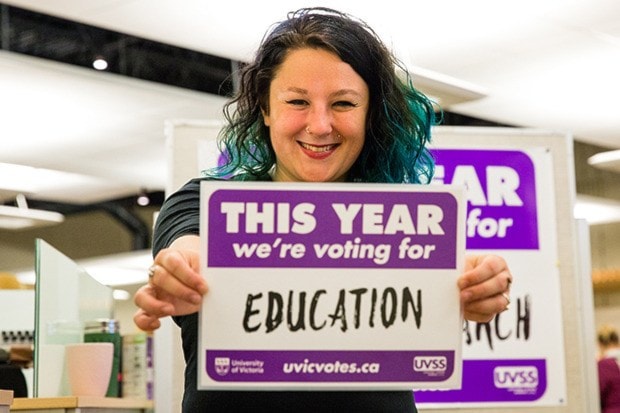Judging by the line of students protruding from the Elections Canada office on campus, the University of Victoria Students’ Society’s all-candidates fair was quite the success.
The UVSS hosted the fair last week – in partnership with the undergraduates of political science – to encourage young people to vote in this year’s federal election. Tables from the Liberals, NDP and Green Party were set up to inform students about each party’s platforms (the Conservatives were notably absent) as well as a polling station, which saw dozens of students waiting more than an hour to vote.
“From what I understand, this is definitely the most succinct and unified campaign that’s ever been run on campus in terms of getting the youth vote out,” said Kenya Rogers, UVSS director of external relations.
In recent years, Rogers said poor young voter turnout and a lack of representation from politicians facilitated a Catch-22 that made voter engagement among the 18 to 25 demographic stagnant. But now, students are challenging the long-held notion that young people don’t vote by, well, voting.
“One of the things that’s really spread across the country, especially coming out of the student societies, is, ‘We’re going to shift that narrative, we’re going to make leaders think about our issues,’” she said, “and once you do that, you start to see students getting more invested and engaged.
“It’s really about empowering students, too. We’re political agents, we’re political actors, we can do this.”
Lindsay Banh, a third-year student taking a double major in political science and history, who is also working for the NDP this election, said such recent events as the passing of Bill C-51 – anti-terrorism legislation that has been criticized over privacy concerns and restrictions to freedom of expression – have gotten young voters more engaged this time around.
“It’s so much more fascinating because all three major parties are so close this year – just the anticipation of actually not knowing what’s going to happen,” she said.
Likewise, Keenan Miller, a third-year history student, said having such a tight electoral race in which either of the two left-leaning parties could unseat the Conservatives has generated interest among young voters.
“This is my first time voting and it’s really interesting, this election, because there are three strong parties rather than a two-party system and a weaker third party,” said Miller.
Mark Erickson, also a third-year political science and history student, credited a stronger push through social media and technology for getting the attention of his demographic.
“There’s just a better effort and larger online presence to try to get the younger vote out than there has been in the past,” he said. “They’re finding better ways to connect with younger people.”
